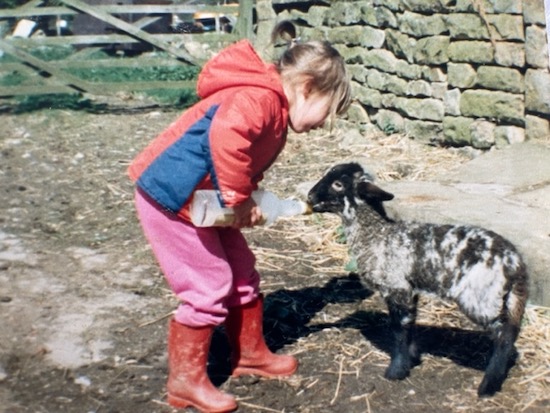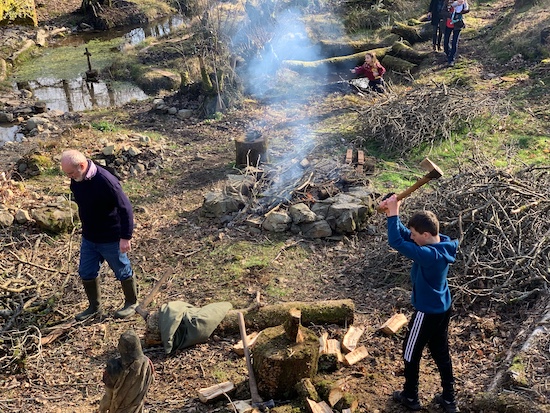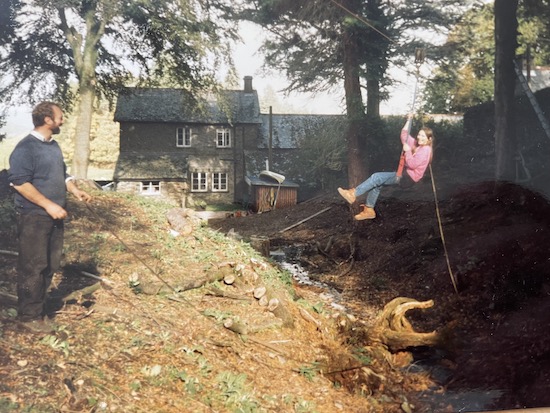In the 1990s, a BBC production team borrowed Rebecca Smith’s “wild looking but tame” rabbit Sherbet for their series The World of Peter Rabbit & Friends. Cast as the real-life Peter, he is shown free on Beatrix Potter’s desk. Flicking pen and paper towards her, he reminds Potter (Niamh Cusack) to write one of the charming animal stories that helped to make the Lake District National Park a global tourism behemoth. Yet for Smith, the daughter of the forester on the nearby Graythwaite Estate who came of age roaming the fells with her walkman as her brother “skinned rabbits on the wall”, this was an irrelevance: “We avoided the Potter-heavy villages and areas that tourists flocked to.” To date, Smith has only visited Potter’s Hill Top Farm once, during the on-location filming that earned Sherbet £80 a day, handed over in a brown paper envelope.
This anecdote epitomises the disconnect that can arise between locals and the commercialised image of iconic landscapes like the Lake District, now visited by almost sixteen million people a year. As Smith writes in her prologue to Rural, a book which combines memoir, travelogue, family photographs and interviews with working class people in rural industries across Britain: “Our lives ran parallel, but our worlds were very different.”
“I am tired of reading a tourist’s view of the countryside,” Smith states, aiming instead to document a “part of society that has been largely forgotten”. This frustration is echoed by a growing number of authors – and not before time. Nature writing as a genre struggles to shake off genteel associations, evoking propertied or excursioning middle-class romantics clasping well-thumbed classics to quote from at length. From a farming standpoint, in English Pastoral (2020) James Rebanks characterises idealising attitudes towards the countryside as a legacy of the Industrial Revolution: “People left the land for towns and cities, and then, a generation later […] they returned to it as a form of leisure and escapism, developing a new kind of relationship with the landscape. […] When we returned, other people, tougher people, were the farmers, and we just loved ‘nature’.”
Rural has a wider scope to examine a broad, though not exhaustive, range of rural occupations and their histories, exploring mining, forestry, millwork, tourism and tenant farming, among others. The countryside is no timeless idyll. Rich in history, it is not a museum but a “working environment”. In the jobs that have survived to this day, accommodation and continuous employment is often precarious, vulnerable to the whims of landlords (including organisations like the National Trust), shifting land practices, and the exponential growth of holiday lets and second homes.
Smith introduces readers to individuals with varying experiences of rural life, whose attachment to their areas or passion for their work keep them going. Dairy farmers Dick and Doreen take a single week of holiday each year. Claudia, a hotel cleaner from Romania, was made redundant in Ambleside during the first pandemic lockdown at twenty weeks pregnant. John, the young gardener of Brodick Castle on Arran, sleeps in a cottage with no central heating and gets “dressed to go to bed in winter”. The past is not romanticised either. Smith’s own pregnancy during most of her research process sharpens her empathy with those forced to endure the hardships of pit disasters and child labour. Nor does she neglect to mention the British countryside’s links to Empire and the slave trade.

Why are the lives of rural working people so marginalised in mainstream culture? Smith points out British literature’s fascination with the ‘Big House’. Think of Austen’s Pemberley, du Maurier’s Manderley and Waugh’s Brideshead. For Smith, the grand pile “represented a space that was not for me” with a “repelling forcefield around it”. Meanwhile, working class experiences are often viewed as simplistically urban. Barry Hines, author of A Kestrel for a Knave (1968), noted his readers’ surprise at his young hawk-trainer protagonist’s access to nature in his South Yorkshire mining town: “Many people still have a vision of the north filled with ‘dark satanic mills’ […] and not a blade of grass in sight […] In the village where I lived, the miners walked to work across the meadows, with sky larks singing overhead”.
Rural shows that this attitude has only consolidated over subsequent years. Smith suspects her upbringing confers a kind of “class ambiguity”. Descriptions of her childhood proximity to lakes, gardens and treehouses lead others to assume that her family was wealthy or well-connected. She has been blithely invited to shooting parties. In an episode of the recent documentary series Grayson Perry’s Full English, the only rural dweller and Cumbrian representative the artist sceptically interviews while questing for the “northern soul”, is Lord Inglewood of Hutton-in-the-Forest.
Ownership is a crucial theme of Rural, both strictly legal ownership and subtler senses of belonging. Landowners – whether benevolent, grasping, indifferent, or rewilding – have the advantage. It is estimated that only 432 landowners possess half of Scotland’s rural land and thirty percent of England is owned by the aristocracy (where, unlike in Scotland, there is no general ‘right to roam’).

At the same time, a wider sense of national ownership over the countryside – famously stimulated in the Lake District by Wordsworth’s class-inflected appeal for “persons of pure taste” to deem the area a “national property” – can conflict with locals’ needs despite providing employment, particularly affecting the availability of affordable housing. Smith frequently presents home owning as the only true security in a time of shorter leases, few remaining tied cottages and inadequate council housing stock, while acknowledging how unachievable it can be. Community trusts are perhaps one solution to the problems of economic precarity and second-home absenteeism, as enacted by the Assynt Crofters’ Trust and the population of the Isle of Eigg.
The story of Smith’s brother Tom, who lives in his own cabin in the woods as a hybrid forester-ecologist-environmentalist-woodcarver, and his partner Lesley is a poignant throughline of Rural, embodying the importance of family and community that lies at the heart of its narrative. Their mum’s small private pension fund enables the purchase of eight acres of woodland, unexpectedly giving Tom long-term stability. Despite this, he still sees himself as a kind of steward, inviting others in to learn and enjoy. Rural is a refreshing and necessary reminder that, like Tom, we should all aspire to be generous caretakers of rural environments and properly appreciate the skills, resilience and perspectives of the working people that sustain them.
Rural: The Lives of the Working Class Countryside by Rebecca Smith is published by HarperCollins


